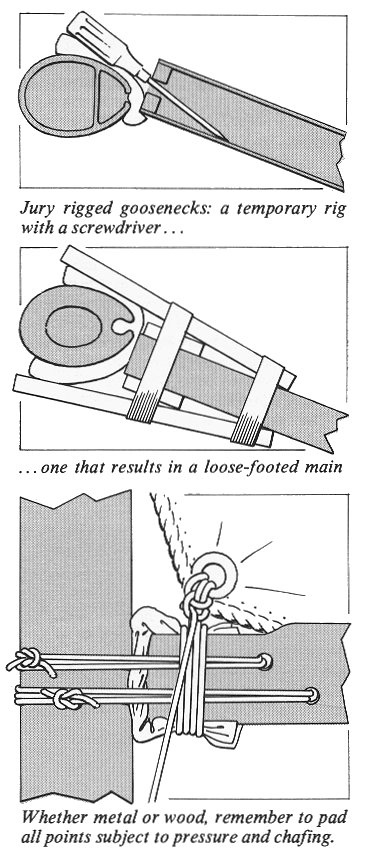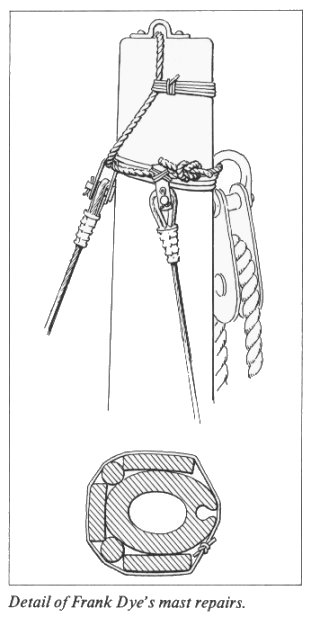|
Spares and Repairs There is no redundancy in dinghy design, and if something breaks far from civilization you must be able to repair it yourself. It is worth thinking about the ways in which you would tackle different problems. A broken centreboard could be one of the worst problems. We have considered carrying a spare (one per fleet), but it is really too big. If it broke near a lee shore, you would probably have to row off, or perhaps by using oars or paddles as leeboards you could try to work to weather under reduced sail. (It would be interesting to try this on home waters, some day.) Given ample time, it might be possible to remove the pivot bolt, plug the holes, and slide a floorboard or other piece of board down the centreboard trunk. This would not be as strong as the centreboard, and it would be necessary to reduce sail considerably. If the rudder blade is not fully down in heavy wind and sea there is a big risk of its breaking. For open-water sailing some skippers drill the rudder blade and cheeks, and insert a pin or bolt to prevent the blade from rising should its hold-down system yield. One sailor drilled a hole near the bottom of his rudder and put a safety line through it and attached it to the rudderhead, so that if his rudder should break, he would at least still have the pieces. To substitute for the rudder, an oar lashed to the transom can serve, but steering with it is said to be hard work. By careful balancing of sails, centreboard, and fore-and-aft trim, it is possible to hold a course almost without rudder action in moderate conditions. Heeling to lee always brings the bow up to weather. Al's note: Tim France suggests fibreglassing rudder blade and centreboard, and I wholeheartedly agree. I have been giving heavy use to my two centreboards and two rudder blades (none of which are under 20 years old!) and not had a single incidence of breakage in over 25 years. When one looks at the scenarios painted by Alan above, the relatively easy job of putting a layer or two of fibreglass (I use West epoxy for this) over the stripped blade or centreboard, seems a small price to pay for a virtual guarantee that you will have no breakage. This of course is always assuming no excessive abuse of such gear. I have
substituted for
a broken gooseneck (when we did not carry a spare) by drilling through
the boom and lashing it to the mast. There are other ways as
circumstances
permit.
 Hull damage, if
limited,
could be repaired temporarily by materials you could carry; fibreglass
and resin, underwater putty, and plywood.
It is worth carrying a spare shroud, made to length with swaged loops. I also carry screw clamps for wire, so that a loop could be made at a broken end and connected to the chain plate with a lanyard of several parts of rope. If a spreader should bend or break, reduce sail until you can replace it. A shroud without a spreader gives much less support to the mast. For the forestay, the jib halyard is a back-up already in place; as I mentioned earlier always tack it down to the bow fitting when you are not flying a jib. If you broke a mast, you would have to rig something. If not repairable, you would have to see what you could do using the boom as a mast, an oar for a boom and maybe the Jib as a loose-footed mainsail. On uninhabited shores in the Great Lakes, there is usually drift wood. as well as growing conifers, so you should not be at a loss for a spar. In his book Ocean-Crossing
Wayfarer, Frank Dye describes how his wooden mast was repaired
after
being broken at sea. All splintered wood was cut out, thus shortening
the
mast by six feet. Splints from boom crutch and whisker pole were lashed
on the front and sides (with spacers between to stop them slipping).
The
spreaders were removed completely. The illustrations show details of
the
cross section and masthead. Even though the sail luff was loose (the
track
was blocked by lashings) the rig was strong enough to work to windward.
 A sail repair
kit,
including adhesive repair tape, should be carried, and perhaps a spare
mainsail per fleet.
Thinking over the above and other repairs that might be necessary should give you a good idea of what tools to carry. You cannot carry everything. A multiple-bit screwdriver is very useful, and if the bits are carried in a compartment in the handle, put some oil in it to combat rust. A wood saw — either wire-and-frame or folding — and a small hack saw are worth taking. Channel-lock pliers save carrying a full set of wrenches. You must be able to undo or tighten every screw and nut in the boat. The following list may be helpful: Tools
|